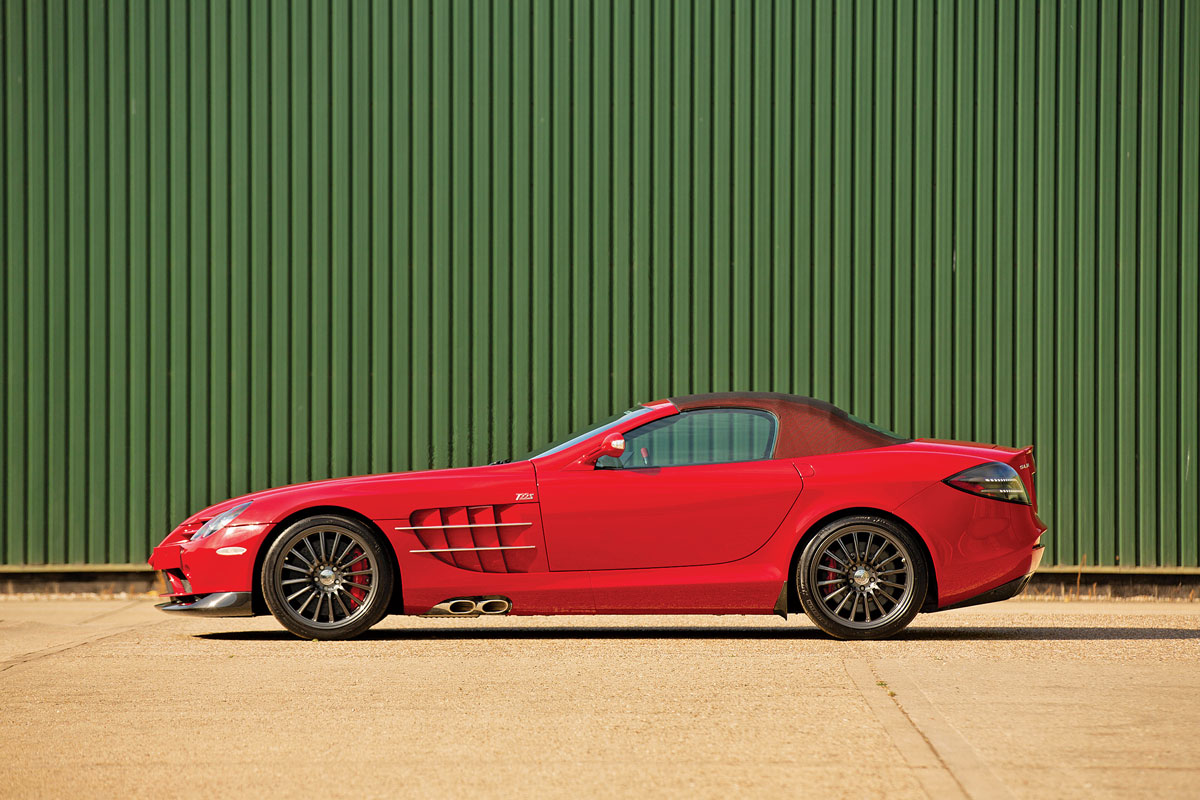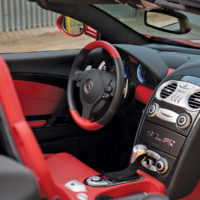Manufactured between 2003 and 2010, their new supercar allowed Mercedes-Benz and its then-Formula One partner McLaren to showcase their collective experience in the development, construction and production of high-performance sports cars. The heart of any car is its engine, and that of the SLR McLaren is truly outstanding. Produced at Mercedes-Benz’s AMG performance division, it is a 5.5-liter, 24-valve, supercharged V8 producing 617 horsepower, making it one of the most powerful engines ever found in a series-produced road-going sports car. Impressive though this peak horsepower figure is, it is the torque produced by this state-of-the-art “blown” motor that is its most remarkable feature. The torque curve is almost flat: There is already 440 lb-ft by 1,500 rpm and well over 500 lb-ft between 3,000 and 5,000 revs.
Needless to say, the SLR McLaren delivers performance figures that are still among the best in its class. Taking just 3.8 seconds to sprint from 0 to 100 km/h (62 mph), it passes the 200-km/h (125 mph) mark after 10.6 seconds and from a standing start takes just 28.8 seconds to reach 300 km/h (186 mph). The 2-seater has a top speed of 334 km/h (207 mph).
Reflecting the long-term technological collaboration that Mercedes-Benz and McLaren enjoyed in Formula One, the SLR’s carbon-fiber composite monocoque body and chassis structure was produced in the latter’s then-all-new facility in Woking, England. The Mercedes-Benz SLR McLaren was introduced for the 2005 model year, priced at $455,000, although choosing from the lengthy list of options could add considerably to the total.
The stylish roadster offered here is an example of the Mercedes-Benz SLR McLaren 722 Edition. This roadster variant of the 722 Edition was unveiled at the 2007 Frankfurt Motor Show as the 722 S. The latter used the same engine and running gear as the coupe, together with the standard SLR roadster’s folding-roof mechanism. Its performance was on a par with that of the closed coupe. The model went on sale in January 2009 and production was limited to 150 units.
SCM Analysis
Detailing
| Vehicle: | 2009 Mercedes-Benz SLR McLaren 722 S Roadster |
| Years Produced: | 2009 |
| Number Produced: | 150 |
| SCM Valuation: | $339,000–$891,000 |
| Tune Up Cost: | $18,000 |
| Chassis Number Location: | Dashboard under windshield |
| Engine Number Location: | Upper left on passenger’s side between the bellhousing and top of the block |
| Club Info: | Mercedes-Benz Club of America |
| Website: | http://www.mbca.org |
| Alternatives: | 2010–12 Lexus LFA, 2009–10 Pagani Zonda roadster, 2009 Alfa Romeo 8C Spider |
| Investment Grade: | B |
This car, Lot 109, sold for $847,441 (€865,000), including buyer’s premium, at Bonhams’ Knokke, Belgium, auction on October 9, 2022.
One of my first adventures as a car-collection manager was to drive a super-low-mile Mercedes-Benz SLR McLaren Stirling Moss on the SCM 1000 AMG Invitational last summer. Driving our Stirling Moss edition is like nothing else, even discounting its roofless, windshield-less, open-air experience. That car, which shares most of its mechanicals with the 722 on which it is based, is little more than a streetable race car. This is a large part of the fun, a feeling that you’re getting away with something compared to the bland sameness of most of the rest of what’s on the road. As Sir Stirling Moss himself said, “If everything is under control, you are just not driving fast enough.”
That quote directly correlates to how these cars operate. The SLR McLaren steering is heavy, the brake pedal is stiff and grabby, and it is awkward to attempt to drive sedately. Given a good bit of road — or, preferably, track — and the right amount of talent and élan, the car comes alive.
Supercar or something else?
The SLR McLaren debuted at the dawn of the modern supercar era, now some two decades past, leading to several variants over its 10 years of production. SLR stands for “Sport Leicht Rennsport” or “Sport Light Racing,” the phrase borrowed from the model’s inspiration, the 1955 300 SLR Uhlenhaut Coupe. (Yes, the very same $142.7m “most valuable car in the world.”)
The first SLR McLaren coupes made 617 hp and 575 lb-ft of torque. This was bumped to 641 hp and 605 lb-ft when the 722 Edition came along in 2006. (The “722” refers to the record-setting car Moss and Denis Jenkinson drove in the 1955 Mille Miglia.) A roadster version of the standard SLR McLaren followed a year later, with the 722 S roadster coming in 2009. The reworked Stirling Moss, a true speedster, arrived the same year and was originally to comprise the final 75 cars before production ended. However, McLaren produced a further 25 cars from 2011 to 2013, all individually customized. In total, 2,157 SLR McLarens were produced, falling short of initial promises of 3,500 units.
Every version of the SLR McLaren walks the supercar walk, with top speeds in excess of 200 mph. However, detractors have maligned it for its GT qualities. Its front-mounted, mid-engine configuration with rear-wheel drive gives the car a characteristically long hood. Inside, the luxury and comfort that have long defined Mercedes-Benz are present and accounted for, including a 5-speed automatic gearbox. Some contemporary testers even described the original model’s ride as “cushy.”
Drive it or save it?
Today, when considering these cars as collectibles, such concerns seem trivial — especially when so many SLR McLarens have been treated more as furniture. With 82 kilometers showing, our subject car is representative of those that have led a mostly static life, neither supercar nor GT. It has been “stored since delivery,” according to the auction company, “and will require recommissioning before further use.”
We are similarly guilty. Before the SCM 1000 tour, our SLR McLaren Stirling Moss had covered a mere 250 miles, leading Ryan Hemphill of The MB Market to comment that on the tour he could see the depreciation coming out of the side exhaust. Afterwards, when we had run the odometer up to 1,400, there was much discussion of whether such use had devalued the car. I believe that the contrary is true: Our participation in the SCM 1000 added value to the car even though it added miles, not only because the car is now ready and able to be driven, but also because it has a story to tell.
The market may not agree. In the past few years, SLR McLaren 722 S roadsters have been selling in the $650k–$800k range. This sale sets a high-water mark. One interpretation of the price here is that miles have a cost, and in this case the value of having saved the car like new is what the buyer paid for.
If that’s the case, we can assume the new owner isn’t going to diminish the value by enjoying this 722 S on the road. I guess there is something to be said for just looking at it. However, with something this visceral and emotional, that is a shame. To use and experience it to its fullest would be much more exciting.
The right color
Our subject car is more than just a pickled prize. Optioned in Fire Opal, with leather in 300SL Red, red-black soft top, special red seat belts, brake calipers in red, leather floor mat edging in 300SL red and a two-tone steering wheel in 300SL red/black, the colorful options set this car apart from the more-common and categorically German Crystal Laurite Silver examples.
Whenever I post about red cars on Instagram
(@heavymetalaffliction), one of my favorite tags is #therightcolor. For me, red is more than notable for resale; it is part of the emotion that sports cars exude. This 722 S roadster is certainly #therightcolor. With so many McLaren SLRs delivered in silver, it’s worth noting that two of the top recent sales have been cars not only with very low miles, but in distinctive colors. It could be argued that the Fire Opal paint and red interior trim package was worth the $100,000 bump alone.
Overall, we should consider this example well sold. Even so, we can still hope the new owner paid up principally for the color, and soon gets this beauty out on the road, mileage be damned. ♦
(Introductory description courtesy of Bonhams.)




